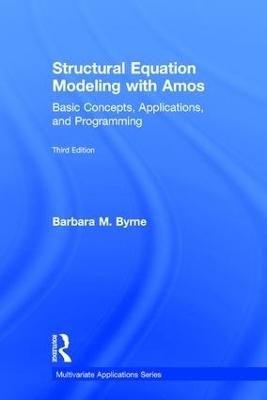
Structural Equation Modeling With AMOS
Routledge (Verlag)
978-1-138-79702-4 (ISBN)
Thoroughly updated throughout, the new edition features:
All new screen shots featuring Amos Version 23.
Descriptions and illustrations of Amos’ new Tables View format which enables the specification of a structural model in spreadsheet form.
Key concepts and/or techniques that introduce each chapter.
Alternative approaches to model analyses when enabled by Amos thereby allowing users to determine the method best suited to their data.
Provides analysis of the same model based on continuous and categorical data (Ch. 5) thereby enabling readers to observe two ways of specifying and testing the same model as well as compare results.
All applications based on the Amos graphical mode interface accompanied by more "how to" coverage of graphical techniques unique to Amos.
More explanation of key procedures and analyses that address questions posed by readers
All application data files are available at www.routledge.com/9781138797031.
The two introductory chapters in Section 1 review the fundamental concepts of SEM methodology and a general overview of the Amos program. Section 2 provides single-group analyses applications including two first-order confirmatory factor analytic (CFA) models, one second-order CFA model, and one full latent variable model. Section 3 presents multiple-group analyses applications with two rooted in the analysis of covariance structures and one in the analysis of mean and covariance structures. Two models that are increasingly popular with SEM practitioners, construct validity and testing change over time using the latent growth curve, are presented in Section 4. The book concludes with a review of the use of bootstrapping to address non-normal data and a review of missing (or incomplete) data in Section 5.
An ideal supplement for graduate level courses in psychology, education, business, and social and health sciences that cover the fundamentals of SEM with a focus on Amos, this practical text continues to be a favorite of both researchers and practitioners. A prerequisite of basic statistics through regression analysis is recommended but no exposure to either SEM or Amos is required.
Barbara M. Byrne is Professor Emeritus in the School of Psychology, University of Ottawa, Canada.
Section 1: Introduction 1. Structural Equation Modeling: The Basics 2. Using the Amos Program Section 2: Single-Group Analyses Confirmatory Factor Analytic Models 3.. Application 1: Testing the Factorial Validity of a Theoretical Construct (First-Order CFA Model) 4. Application 2: Testing the Factorial Validity of Scores from a Measurement Scale (First-Order CFA Model) 5. Application 3: Testing the Validity of Scores from a Measurement Scale (Second-Order CFA Model) Full Latent Variable Model 6. Application 5: Testing the Validity of a Causal Structure Section 3: Multiple-Group Analyses Confirmatory Factor Analytic Models 7. Application 5: Testing Factorial Invariance of Scales from a Measurement Scale (First-Order CFA Model) 8. Application 6: Testing Invariance of Latent Mean Structures (First-Order CFA Model) Full Latent Variable Model 9. Application 7: Testing Invariance of a Causal Structure Section 4: Other Important Applications 10. Application 8: Testing Evidence of Construct Validity: The Multitrait-Multimethod Model 11. Application 9: Testing Change Over Time: The Latent Growth Curve Model Section 5: Other Important Topics 12. Application 10: Use of Bootstrapping in Addressing Non-normal Data 13. Application 11: Addressing the Issues of Incomplete Data
| Reihe/Serie | Multivariate Applications Series |
|---|---|
| Zusatzinfo | 70 Tables, black and white |
| Verlagsort | London |
| Sprache | englisch |
| Maße | 152 x 229 mm |
| Gewicht | 748 g |
| Themenwelt | Geisteswissenschaften ► Psychologie |
| Mathematik / Informatik ► Mathematik ► Angewandte Mathematik | |
| ISBN-10 | 1-138-79702-2 / 1138797022 |
| ISBN-13 | 978-1-138-79702-4 / 9781138797024 |
| Zustand | Neuware |
| Informationen gemäß Produktsicherheitsverordnung (GPSR) | |
| Haben Sie eine Frage zum Produkt? |
aus dem Bereich


